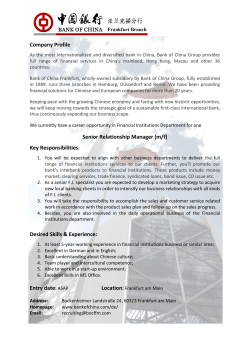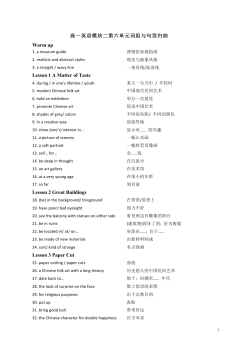
Catalog - Mark Tanous
Deep in the Blues Treasures from the Monterey Bay and beyond Mark Tanous MUSEUM OF MONTEREY Mark seems to be about having a fine old time with art.... certainly this is the most fun I have ever seen had with stoneware, which is a notoriously prim old maid for the most part, even worse than blowing glass. You know glass and stoneware might seem to be all cute and pretty but there is no substance. Now I don’t know if Mark’s colors have anything to do with the Monterey Peninsula, though admittedly the closest I usually get to that is Castroville to buy some artichokes, but they are great colors and seem to me to be all Mark. Mark, I am sure, always has a great fine time and lets no moss grow on the bottom of his feet. – David Gilhooly Deep in the Blues Treasures from the Monterey Bay and beyond Disclaimer Due to the natural variations of clay and minerals, which limit our control, and the variety of applications for our pieces over which we have no control, our pieces are sold with the understanding that the user is solely responsible for determining suitability for any purpose. Therefore, our maximum liability shall be limited. No guarantee is expressed or implied regarding consistency or viability of our pieces. Nor will we be responsible. THE REDUCTIONISTS Deep in the Blues Copyright © 2011 by Mark Tanous, All rights reserved. Printed in the United States of America. No part of this catalog may be used or reproduced in any manner whatsoever without written permission except in the case of brief quotations embodied in critical articles and reviews. For information address Mark Tanous: tanousceramics@gmail.com This catalog may be purchased at MagCloud.com. Design: Takigawa Design. Dear Friend, Most of the pieces in this collection have been in the private residence of Anthony Jazper and Gaia Fortuna. As long time Peninsula residents, Anthony and Gaia spent a great deal of their life traveling up and down our coast collecting objects of desire. They were especially interested in ceramics. This catalogue contains selected pieces and the accompanying stories. Ever curious, Gaia asked many questions and kept notes on the lives of the pieces before they came into the J&G collection.Gaia passed before Jazper and after she left his side, he lost the desire to acquire. He said, “Before I had beauty at my side and they were just things. Now it would be as if I were trying to replace her true beauty in my life.” On their passing, it was their wish that the collection be shown at the Museum of Monterey and sold off to those who wished to start their own collections. So please enjoy the fruits of their labors, they sure did. Mark Tanous & The Reductionists fishing village Gaia and I started collecting on a whim. We were young, in love, and discovering the world and the water’s treasure together. She was new to California, I had been here since I was three. I knew nowhere else. I like to say my family were descendants of the Phoenician, the great shipping tribes of the eastern Mediterranean. She was from Sicily. We both loved the water. We swam, boated, or just laid in the sand as often as we could. And we collected… We started casually; first at a tag sale picking up a few curiosities, then getting more serious looking for specific items that turned out to be ceramics. We found there was lots of information about styles, firing temperatures and atmospheres. We decided to educate ourselves. Our first real find was a group of pieces from a Chinese finishing enclave located above the San Francisco Bay. We had had a very successful day of abalone fishing and our pockets were full of cash. Gaia saw an unassuming wooden sign leaning against a tree that read: curios. We made our way up to a small cluster of cabins tucked in the forest. One had the tell-tale signs of retail: an open door and a designated parking spot. As we entered we were greeted by an elderly Chinese man. His store was packed, dusty, and dark. We noticed a glass case tucked in the corner. It was illuminated by light spilling in through an open window. When we approached the glass case the man said, “You have a very good eye.” The case held half of a dozen bright blue vessels. At first they appeared to be made of turquoise, sort of a coral turquoise. He said they were found off the coast by his sister. She was a free diver from the old school. She would row her little boat out into the bay filled with rocks. She would grab a rock and jump over the side giving her more time at the bottom to explore and gather shells. During one of her trips she came across what seemed to be a small boat that had sunk and was partially covered with sand. She could see some bottles and made a few dives to retrieve them. She knew a storm was coming in and quit for the night She knew there were more and planned to go out the following morning. The elderly Chinese man said he never saw his sister after that morning. “My parents told me,” elderly man said. “A wave capsized her boat. They thought one of the stones must have hit her and she never came back. That was 92 years ago. I was 4.” Gaia and I purchased the set of bottles and their story and our adventure began. Blue Tear 2 Blue Collar Blue Wind 3 Bottle Earth 5 I n k B O TTLES Fallen Oak a2 Fallen Oak 6 After the Great Opium War and the demise of the British East India Company, the opium and heroin trade changed direction. It moved from China to the U.S. and Europe. As the trade became more popular and more lucrative the bad guys started to take over. Winston Chong, a Chinese entrepreneur, came up with a plan to smuggle this precious commodity. He created the Fallen Oak INK company. His signature bottle had an acorn-like drape over the shoulders of his containers. During the day he filled his bottles with deep, dark ink and in the evenings he filled a few with deep, dark liquid heroin to ship to the Barbary Coast. Printers and typesetters in San Francisco became his distribution arm. The bottles that are stamped with BLK 47 were used to smuggle the heroin. It is thought that the number 47 represents the number of days between when Chong conceived of the idea and when he got his first profit. Fallen Oak 1 That’s Deep Bruce Cobalt Tiger Before Bruce took the “straight” job at the Marine Lab, he ran diving boats out of the Moss Landing Harbor. He would jump in the water and salvage every chance he got. They say he spent more time in the water than on land. His original training was as a Navy Seal in Guam during the war. When his stint in Guam ended he spent a few years bouncing around Asia. After the Music Revolution of the 60s, he moved back to California where he bought a boat and ran up and down the Central Coast accruing pieces he found interesting. His collection was eclectic and varied--just like him. Gaia and I spent a couple days every summer with Bruce until he lost his license for “parking” his boat in the Harbor Master’s quarters at the lighthouse, twice. Croc Crock 3 Repair Scarlett Brew Volcanic Repair k a v a bo w l Gaia and I were good friends with Coleman West. Coleman had been fishing the rocks in Big Sur for most of his life. He made a meager living selling fish to the restaurants up in Carmel. He was a poke pole fisherman. Eight feet of bamboo, foot and a half of baling wire, eight- ten inches of fishing line and a hook. Coleman would move down to the shoreline at low tide and put his baited hook in the crevasse and hollows of the rocks and wait for a rock fish to bite. Back then, in the late forties, there were plenty. Coleman grabbed these Kava bowls out of a cave near Nepenthe. It was tradition for the South Sea sailors to bring with them their bowls for making Kava liquor. Coleman thought these were from Tahiti but we realized that the crab insignia was a West Coast variety and were made here by some enterprising craftsman. Imitation is the highest form of flattery. Kava 4 de menthe Honey Jar Detail Wild Bill had told me about DeMenthe--how she had that kind of arresting beauty that left you thankful for sight. Man, was he right…again. DeMenthe filled your lungs with air and put a smile on your face. We found her little place near Doc’s lab.Wild Bill had told me that she was a recluse. He had said, she didn’t socialize any more. She claimed it drained her energy. She also claimed “All the interesting people are dead.” Her place was a smart mix of Zen Temple and the Louvre. It was filled with beautiful things that calmed us. What caught our eye, and what we were lucky enough to acquire from her, were a set of Three Vases. They were beautiful in a strange way; purple veins seemed to grow out of the the blue bottom and reach up to a yellow rim. She had a boyfriend who worked as a lifeguard at Still Water Cove back when Del Monte Forest was run by the Morses’. One day one of these vases washed up from that clear emerald water and on to the white sandy beach. The vase had the texture of coral and was the color of tropical fish. He grabbed a mask, swam back into the surf and retrieved two more vases. It turned out they were butter jars from a Portuguese fishing boat that had been on its way up the coast to San Francisco. Eighty years in the bay will do that to a pot. Stillwater z3 nectar roc Nectar 1 Nectar 4c Nectar 2 Robert Obrien Carlyle had a women’s shop off of Market. The shop carried hats, bags, and his own line of cosmetics. His most popular product was a face and body lotion called “Island Nectar.” “Island Nectar” was just plain coconut oil he imported from Hawaii in large ceramic vessels. He told his customers a story of these nut-brown young men scaling the trees to knock down the nuts. He said they sweltered in the heat of the fire to render out the oil. He painted an island paradise for his female customers. Robert was a clever marketer. In the winter of 1898, a small cargo ship sunk off the coast after hitting an out cropping of rocks near the Golden Gate. Gaia and I found the jars that were used to import the oil at a little shop in North Beach. Richard, who sold us these pieces, said Robert Obrien Carlyle was upstairs asleep. They had been partners for fifty-eight years. Nectar 3 Ferris Taub & Henry Miller Taub Banded They say Miller got the name from Taub, but I think Taub got it from Miller. Their friendship began in Paris during the Great Depression. Miller was writing, trying to find another glass of wine. Taub was drawing and painting before finally settling on clay as his medium. Like everyone else in Paris, he was trying to make a living. Along the way, he realized if he made some functional pieces, along with his “arty” stuff, he could sell it to the women in the markets. Taub and Miller loved Paris: the smell, the taste, the women. Oh, and the city itself. After a long decade of drinking and creating, they started to long for their native tongue so they moved back to the States. While traveling they stumbled upon Big Sur. Miller immediately fell in love, and although he had no means, he stayed down the coast. Ferris, on the other hand, saw opportunity on Cannery Row. He opened a bar to service the fishermen and the canning crews. He called it Tropic of Decanter as a “tip of the hat” to his long time friend Henry, and to their time together in Paris. Ferris found the bar life to be draining. To fill his personal reservoir he began to pot again. He created a series of simple bottles that he displayed and sold in the bar. Gaia and I found most of these pieces at tag sales in Pacific Grove and Carmel. Emerald Oil Taub Sweet 1 Taub Balloon 6 Taub Shino Dot 3 chinese water jar Chinese Water r4 Chinese Water a The people of the Guan Zhou region of China had a very special relationship with water. It was so scarce that families would have to receive water rights from Emperor Soolip before they could move to the region. Water rights were granted in the form of a medallion, which the senior female in the household would wear around her neck. When families started immigrating to California they brought water from their rivers in the jars marked with the medallion. This water was used on special occasions to welcome a child into the world, or to cleanse the lips of a bride to be, or offered as the last sip before dying. These jars held a special place in the lives of their owners. Gaia and I collected these five medallions over a twentysix year period, which began in 1949. Chinese Water b3 Chinese Water d1 ACKN O WLE D GEMENTS Funding for this exhibition was provided by Celadon, Inc., a nonprofit arts funding organization, Dr. Richard Kanak, and Dr. David Shin. Deep in the Blues could not have been realized without the many individuals who have lent support for this exhibition. I would like to express my thanks to Museum of Monterey and its Board for hosting the exhibition. I am grateful to my family and friends for their support and contributions to this project, particularly Jennifer Holmes, Dylan, Hunter and Scarlett Tanous. My parents, Joseph and Louise Tanous. This project is only possible with the support and contribution of: Jim Wood Photography Celadon, Inc. Mario Castro, website creative and design John Micheletos Dylan Tanous edicted buy Mark Baer, video John Enns Diane Eisenbach Victoria Thompson Jennifer Holmes, muse Gail Enns, curator The Reductionists Chris Horsley of Mike’s Signs Finally, we thank Jerry Takigawa and his design staff. Our dental practice is devoted to comprehensive and preventive care, in a friendly and relaxed environment. Services provided include: •General Dentistry •Cosmetic Dentistry •Teeth Whitening •Root Canal Therapy •Porcelain Veneers, Crowns & Bridges •Tooth Color Fillings •Periodontal Treatment •Cleanings & Exams •Teeth Extractions •Dental Implant Restorations David Shin, DDS New Patients and Emergencies Welcome! Most Insurances Accepted. RYAN RANCH DENTAL CARE 21 Upper Ragsdale Drive, Suite 170, Monterey, CA 93940 | 831-375-2600 www.drdavidshin.com Cardio-Pulmonary Associates Medical Group, Inc. SERVING THE MONTEREY PENINSULA SINCE 1979 Richard Kanak MD, FCCP, FAASM Sleep & Pulmonary Disorders Board Certified, Sleep & Pulmonary Medicine A team of physicians and support staff dedicated to the care of Individuals with Cardiac, Respiratory and Sleep Disorders Evaluation and Treatment of: • Sleep Apnea & Snoring • Restless Legs Syndrome • Narcolepsy • Daytime sleepiness • Insomnia 30 Garden Court | Monterey, CA | 646-8570 | www.cpamg.com MUSEUM OF MONTEREY www.museumofmonterey.org
© Copyright 2025









